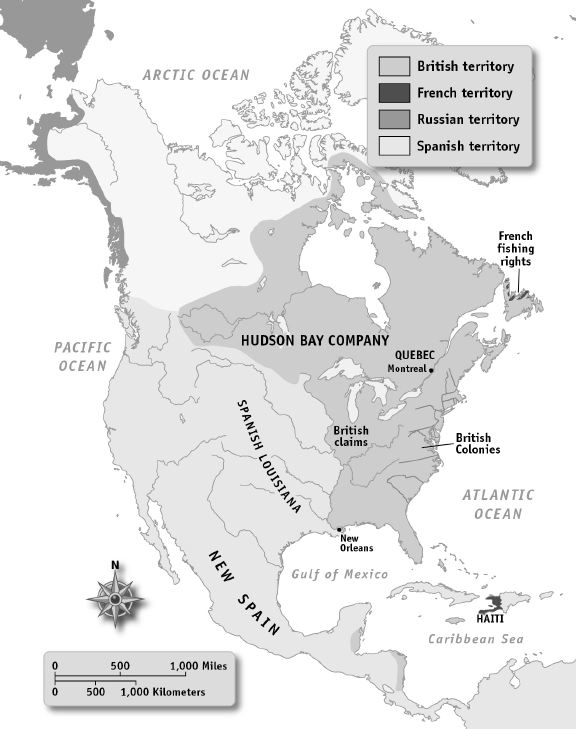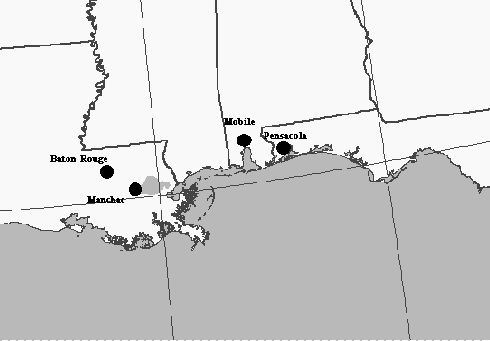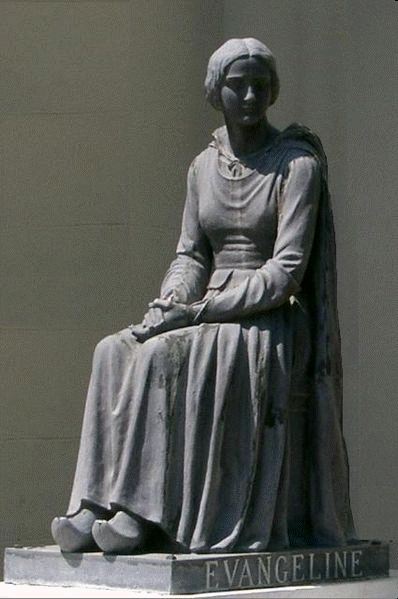Multiple Choice
Identify the
choice that best completes the statement or answers the question.
|
|
|
1.
|
In which conflict did France lose all of its
land holdings in North America?
a. | Revolutionary War | b. | War of Jenkins’s Ear | c. | French and Indian War | d. | War of the Spanish
Succession |
|
|
|
2.
|
What body served as town council and court of law
during the Spanish colonial period?
a. | Balize | b. | Cabildo | c. | Depositoire | d. | Superior
Council |
|
|
|
3.
|
What treaty transferred Louisiana from France to
Spain?
a. | Fontainebleau | b. | Paris of 1763 | c. | Paris of
1783 | d. | Versailles |
|
|
|
4.
|
Which Spanish governor of Louisiana has been
described as a reserved scientist, quiet, low-keyed, and noted scholar?
a. | Alejandro O’Reilly | b. | Antonio de Ulloa | c. | Francisco
Bouligny | d. | Luis de Unzaga y
Amezaga |
|
|
|
5.
|
Which explains why the Louisiana colonists were
angry with Governor Ulloa?
a. | He passed a law that ended the slave
trade. | b. | He passed a law that implemented Spanish trade
laws. | c. | He passed a law that restricted travel except for
expanding business. | d. | He passed a law
that made the Catholic Church the official church of the
colony. |
|
|
|
6.
|
Who was the governor of Louisiana during the
American Revolution?
a. | Bernardo de Gálvez | b. | Esteban Miro | c. | Luis di Unzaga y
Amezaga | d. | Oliver Pollock |
|
|
|
7.
|
What hindered the military movement of the Spanish
in the Gulf of Mexico during the American Revolution?
a. | hurricanes | b. | unsafe harbors | c. | unseaworthy
ships | d. | superior British
navy |
|
|
|
|
|
|
8.
|
How is the location marked on the map related to
the popularity of Governor Ulloa with Louisiana’s colonists in the 1760s?
a. | Ulloa refused to rebuild the area after it was destroyed
in a hurricane. | b. | Governor Ulloa
angered colonists when he forced many of them to relocate to the Mississippi
Delta. | c. | Fort Balize was a great distance from most of the
colonial population, yet Ulloa used it for many important events. | d. | Ulloa set up an aquatic tollbooth to collect money from merchants exporting
goods to countries other than Spain. |
|
|
|
9.
|
What is marked by the black dot?
a. | Cabildo | b. | Fort Balize | c. | New
Orleans | d. | Superior Council |
|
|
|
10.
|
Which explains why the Louisiana colony was a low
priority for the Spanish after they acquired the territory from the French in 1762?
a. | Spain was busy fighting England in the American
Revolution. | b. | Spain knew that
the colony had been a financial disaster for France. | c. | Spanish leaders were occupied with the slave revolt in
Saint-Domingue. | d. | French colonists
in Louisiana attacked Spanish ships to show their dissatisfaction with the shift in
power. |
|
|
|
11.
|
Which explains why Ulloa hesitated to take formal
control of the Louisiana colony?
a. | a smallpox outbreak and few medical
supplies | b. | language barriers and an unwelcoming
population | c. | a limited number
of troops and an unwelcoming population | d. | conflicts with
Native American groups and a smallpox outbreak |
|
|
|
12.
|
Which body did Governor Ulloa allow to continue to
assist in governing the Louisiana colony?
a. | Cabildo | b. | Judicial Branch | c. | Parliament | d. | Superior
Court |
|
|
|
13.
|
How is the French Superior Council related to the
Revolt of 1768?
a. | Council members sold Louisiana to the
Spanish. | b. | Council members provided weapons to dissatisfied
citizens. | c. | Council members encouraged citizens to openly rebel
against Spanish rule. | d. | Council members
charged citizens who participated with treason and had them sentenced to
death. |
|
|
|
14.
|
Which explains how Etienne de Boré affected
the sugar industry in Louisiana?
a. | He made sugar production
profitable. | b. | He discouraged
planters from raising sugar cane. | c. | His farming
methods doubled the crop potential for one field. | d. | His high volume of sugar production flooded the market and lowered the
price. |
|
|
|
15.
|
North America After the French and Indian War  Which statement summarizes the map’s information about land claims in
North America at the end of Britain’s war with France in the French and Indian
War? Which statement summarizes the map’s information about land claims in
North America at the end of Britain’s war with France in the French and Indian
War?
a. | France’s history in Louisiana allowed it to
maintain control of large amounts of territory after the war. | b. | The British gained control of most of North America with little French
territory remaining. | c. | France’s
territory after the war gave the country many ports for trade in the New World.
| d. | Spain was free to claim much of North America since the
French lost much territory. |
|
|
|
16.
|
Which of the following reasons caused Spain to want
to take possession of Louisiana from the French?
a. | to end Acadian migration into Louisiana
territory | b. | to gain control of Fort Toulouse in north of Mobile
| c. | to protect their land claims in Mexico from the British
| d. | to connect their Canadian holdings with their other
territories |
|
|
|
17.
|
Who did Spain support during the French and Indian
War?
a. | Britain | b. | Canada | c. | France | d. | United
States |
|
|
|
18.
|
Why was Spain willing to take control of Louisiana
even though the colony had not been profitable for France?
a. | to sell it to the British at a
profit | b. | to end the French and Indian
War | c. | to protect their Mexican silver
mines | d. | to expand their west coast land
holdings |
|
|
|
19.
|
What were the conflicting goals of France and
England in the 1750s that eventually led to war?
a. | Britain wanted to control the fur trade while France
wanted to expand to the west. | b. | Britain wanted to
expand to the west while France wanted more control of the east coast. | c. | France wanted to link Louisiana and New France while the British wanted to
control the Mississippi River. | d. | France wanted to
control the fur trade and link their land holdings while the British wanted to expand to the
west. |
|
|
|
20.
|
What was one way the Spanish tried to reduce the
cost of maintaining the Louisiana colony?
a. | They sold Louisiana’s Native Americans as slaves
to southern plantation owners. | b. | They tried to make
existing French government structures work with Spanish laws. | c. | They allowed the colonists to govern themselves if they agreed to pay Spanish
taxes. | d. | They allowed the colonists to continue their established
trade practices to avoid conflict. |
|
|
|
21.
|
How did O’Reilly’s arrival in Louisiana
differ from Ulloa’s?
a. | The colonists welcomed him
warmly. | b. | The colonists rioted and demanded he
leave. | c. | He spent time in the Mississippi River
Delta. | d. | Spain provided a great show of military
support. |
|
|
|
Use the picture to answer the next question(s). 
|
|
|
22.
|
What historic landmark is shown in the
picture?
a. | Cabildo | b. | Capital Building | c. | Governor’s
Mansion | d. | St. Louis
Cathedral |
|
|
|
23.
|
It what way does this building represent
Louisiana’s cultural history?
a. | It is used as the Governor’s
mansion. | b. | It is the home of the Creole Historical
Society. | c. | It was built as a replica of colonial style
architecture. | d. | It combines
Spanish arches with a French Mansard roof. |
|
|
|
24.
|
What was known as Code
O’Reilly?
a. | the Cabildo | b. | Creole folk song | c. | password for
trading with the British | d. | new laws based on
Spanish Laws of the Indies |
|
|
|
25.
|
What was Alejandro O’Reilly’s primary
focus as Governor of the Louisiana colony?
a. | developing more regular trade
practices | b. | establishing Catholicism as the accepted
religion | c. | establishing a large military presence to stop British
migration | d. | relocating Native Americans to reservations to open more
farm land |
|
|
|
26.
|
Read the passage and then answer the next question. 
Which elaborates on Unzaga’s recommendation in the
passage?a. | They could then send their family’s money back to
Spain. | b. | This would allow them to eliminate French bloodlines and
customs. | c. | This would assist in their assimilation and acceptance
with the colonists. | d. | They could then
encourage the most wealthy French families to return to
France. |
|
|
|
27.
|
How did Gálvez’s economic approach
differ from Ungaza?
a. | Gálvez encouraged British trade while Ungaza
considered it treason. | b. | Ungaza was
laissez-faire about British trade while Gálvez regulated it with
taxes. | c. | Gálvez actively worked to control trade while
Ungaza was laissez-faire in this economic approach. | d. | Ungaza legalized British trade while Gálvez worked hard to eject British
traders from their role in the economy. |
|
|
|
28.
|
Which was a direct result of the French and Indian
War?
a. | The French lost the Louisiana
colony. | b. | The Spanish doubled their Canadian
territory. | c. | The British lost
control of the thirteen colonies. | d. | The British gained
control of the Louisiana colony. |
|
|
|
Use the map to answer the next question(s). 
|
|
|
29.
|
Why did Governor Gálvez lead military actions
against the forts and outposts at Pensacola, Mobile, Baton Rouge, and Manchac in the
1770s?
a. | to give Spain control of the Atlantic coastal waters and
the Gulf of Mexico | b. | to allow for
easier attack on the 13 British colonies in North America | c. | to weaken the British forces during the French and Indian
war | d. | to give Spain control of several important
harbors |
|
|
|
30.
|
 How is this statue
related to Louisiana’s history? How is this statue
related to Louisiana’s history?a. | She is a symbol of the Acadians and their migration to
Louisiana. | b. | She memorializes
the daughter of a wealthy Louisiana landowner. | c. | She is a symbol of
the women who worked in the suffrage movement. | d. | She is a
representation of the womens’ liberation movement in
Louisiana. |
|